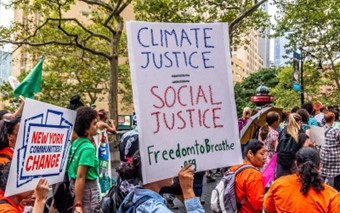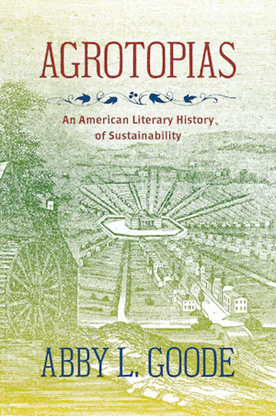By Abby L. Goode
I begin Agrotopias with the following sentences: “We Can’t Solve the Climate Crisis Unless Black Lives Matter” and “Climate Change Is Also a Racial Justice Problem.” These 2020 headlines reflect the urgent calls of antiracist and environmental justice advocates as the COVID-19 pandemic and George Floyd’s murder shook the world. During this time, many organizations announced their commitment to antiracism, including the well-known environmentalist group the Sierra Club. In an announcement entitled “Pulling Down our Monuments,” director Michael Brune acknowledged the Sierra Club’s racist and eugenicist history and pledged to center voices of color in future work. But even as US environmentalists now confront their racist and eugenicist legacies – even as environmentalists critically reexamine figures such as John Muir and Theodore Roosevelt – the deeper origins of this history remain largely unexamined and, in some cases, insidiously intact.

Copyright: Fred Murphy, 2018. License details.
With Agrotopias, I wanted to shed light on those origins – to reach back to Thomas Jefferson’s time and uncover the deep-rooted partnership of US racial, reproductive, and environmental ideas. While “sustainability” is a fraught and ambiguous term, often used for green consumerism campaigns, sustainability rhetoric emerges from a sense of threat, a sense that the future is in peril and that something needs to change. Whether or not early US writers used the term “sustainability,” they surely engaged in early sustainability rhetoric, responding to threats both real and perceived. For many writers throughout the nineteenth century, Jefferson’s vision of a small-farming republic seemed increasingly threatened by urban population growth, racial heterogeneity, and reproductive chaos. These writers attempted to rescue Jefferson’s ideal, promoting agrarian principles of small farming and environmental stewardship as antidotes to what they saw as impending population crises.
In some ways, these early sustainability arguments are not unlike those that today advocate for a so-called “return” to rural living, local economies, and land stewardship. But rather than simply rehearse the argument that small farming is good for their land and communities, early sustainability advocates reshaped agrarianism to develop a distinctly eugenic conception of sustainability: the ability to feed and breed a racially homogeneous, American small farming population, even beyond US borders.
As I emphasize in the book, early sustainability advocates were interested in shaping just as much as sustaining the American population. Their rhetoric has infiltrated some of the most prominent forms of US environmental discourse: population control, natural resource conservation, wilderness preservation, and locavorism, to name a few. Given this rhetoric’s often quiet persistence, it is perhaps no wonder that early Sierra Club members were also prominent eugenicists, or that, today, the Sierra Club is working to “pull down its monuments” amid escalating environmental and racial justice crises.
As writers engaged in early sustainability rhetoric, they imagined perfected, sustainable societies elsewhere, or what I call agrotopias. Agrotopias are idealized worlds of environmental abundance and agrarian stability. They are comforting alternatives to the unsustainable conditions of the present. The book’s cover image, for instance, reflects an agrotopian fantasy: a highly ordered, rural, egalitarian community in the US West, far away from the tumult, dinge, and supposed promiscuity of crowded, Eastern cities. (This image graced the front page of many issues of Young America, a prominent labor and land reform newspaper from the 1840s.) In the late eighteenth, nineteenth, and early twentieth centuries, many agrotopias were characterized as much by sexual discipline and reproductive order as they were by small farming, stewardship, and independent labor. In fact, as writers such as Walt Whitman, Charlotte Perkins Gilman, and even Jefferson himself envisioned agrotopias, they adapted agrarian ideals to concepts of selective breeding and so-called “racial improvement.”

Agrotopias cover illustration: Agrarian township image from Young America newspaper, mid-1840s. Courtesy American Antiquarian Society.
Ultimately, agrotopias are forms of escape. For those writers imagining them, they exist beyond the threat of overpopulation, poverty, and environmental decline. Instead of addressing unsustainable conditions, agrotopian visions prioritize starting over in a new “New World” – often in ways that reproduce expansionist and settler-colonial ways of thinking.
As I wrote this book, I wanted to think about how fantasies of escape and deferral have long shaped environmental discourses – how imagining a utopian elsewhere can become more appealing than confronting the messiness of the here-and-now (a distinct goal of environmental justice struggles). In the past few years, utopian communities have received increased attention. In her 2020 bestseller How to Do Nothing, Jenny Odell discussed digital detox retreats and 1960s communes as modes of “resisting the attention economy.” That same year, a New York Times article entitled “The New Generation of Self-Created Utopias” shed light on the increased popularity of intentional communities and “the value of opting out of contemporary society.” But intentional communities, retreats, utopias, and all manner of clean slates and withdrawals have their limitations. What or who gets left behind when some individuals “opt out of contemporary society”?
What we learn in Agrotopias is that early writers – gothic novelists, poets, labor activists, ecofeminist thinkers, and US Presidents – engaged in these kinds of fantasies, often in ways that sought to leave behind the most vulnerable, poor populations of their times. This is why, in the book’s epilogue, I briefly discuss environmental justice paradigms as powerful, long-standing alternatives to agrotopian thinking. From Chico Mendes to the Standing Rock Sioux Tribe, from Wangari Maathai to Flint, Michigan, residents, environmental justice activists have sought to remain in place rather than imagine a utopia elsewhere – to demand that their communities have access to the ecological commons, including clean water, thriving forests, and breathable air.
But this book focuses so much on critique – so much on excavating this problematic history – that it might leave readers asking, “What now?” or “How can we make this book work?” Students, too, often ask similar questions as they confront a challenging level of pessimism in the face of anthropogenic climate change, rapacious ecological extraction, industrial pollution, environmental racism, and slow violence. Rather than supply a clear answer, teachers can invite students to supply their own responses, thereby inviting them into an authentic and urgent conversation. For instance, in many of my environmental studies courses, the goal is to use critique (of environmental discourse, of “sustainability” as a term) as a catalyst for creative practice – for engagement in critique-informed activism and community-engaged projects. As I wrote in an essay entitled “Against Sustainability,” critique plays an important role in the classroom. In my own experience, it has functioned as intellectual motivation for student-designed initiatives ranging from rooftop gardens to transparent trash cans to cardboard furniture installations.

A few years ago, I piloted a project-based, interdisciplinary course entitled “American Food Issues: From Fast Food Nation to Farm Stands,” a course which, in many ways, most directly relates to present-day agrotopian thinking. In this course, students engaged in contemporary debates about food justice, organic farming, and locavorism, confronting the consumerism, racism, and sexism that lurks within some forms of agrarian nostalgia today. Drawing on those debates, students collaborated across their majors (practicing what I call “Slow Interdisciplinarity”) to develop and implement their own solutions to pressing food issues within their communities. They spearheaded community food recovery programs and distributed seedlings from local farmers at university events. One group developed and secured external funding for a centrally located community cupboard that radically expanded pantry resources for food insecure students. Though these students graduated in 2020, their work continues to feed countless campus community members. Of course, these and other student-driven projects do not solve all of the world’s problems (and neither does a single work of scholarship). But through them, students practice their own authority, creativity, and agency in the face of pervasive environmental injustice.
In this same way, Agrotopias invites its readers to consider the question of “what now?” – to rethink and revisit contemporary forms of environmental discourse and practice. What changes when we recognize that early conceptions of sustainability – many of which are still with us today – are integrally entangled with eugenic and xenophobic ways of thinking?
[Note: Material from this blog post has been adapted from Agrotopias: An American Literary History of Sustainability (UNC Press, 2022).]
 Dr. Abby Goode is an Associate Professor at Plymouth State University in New Hampshire, where she teaches in the English and Sustainability Studies programs. She is the author of Agrotopias: An American Literary History of Sustainability (UNC Press, 2022), which was featured on the New Books Network podcast in September 2022. Her research appears in venues such as Early American Literature, ESQ, Studies in American Fiction, Hybrid Pedagogy, and American Studies in Scandinavia. Her work has been supported by fellowships from the American Council of Learned Societies (ACLS), the American Association of University Women (AAUW), the American Antiquarian Society, the Institute for Citizens and Scholars, and the First Book Institute at the Center for American Literary Studies at Penn State.
Dr. Abby Goode is an Associate Professor at Plymouth State University in New Hampshire, where she teaches in the English and Sustainability Studies programs. She is the author of Agrotopias: An American Literary History of Sustainability (UNC Press, 2022), which was featured on the New Books Network podcast in September 2022. Her research appears in venues such as Early American Literature, ESQ, Studies in American Fiction, Hybrid Pedagogy, and American Studies in Scandinavia. Her work has been supported by fellowships from the American Council of Learned Societies (ACLS), the American Association of University Women (AAUW), the American Antiquarian Society, the Institute for Citizens and Scholars, and the First Book Institute at the Center for American Literary Studies at Penn State.
Twitter: @abbylgoode
